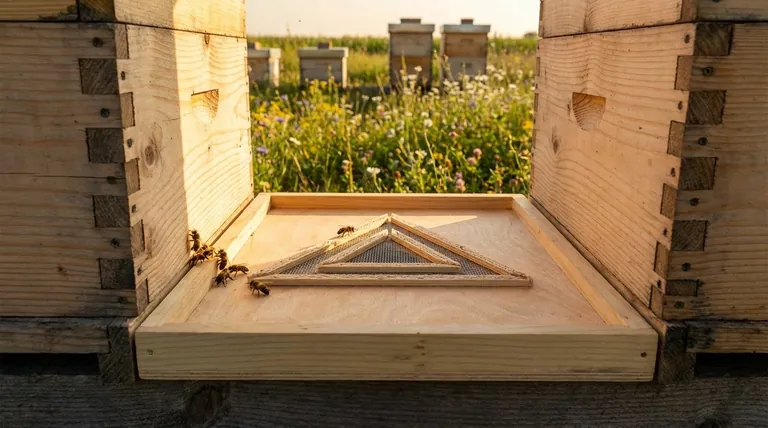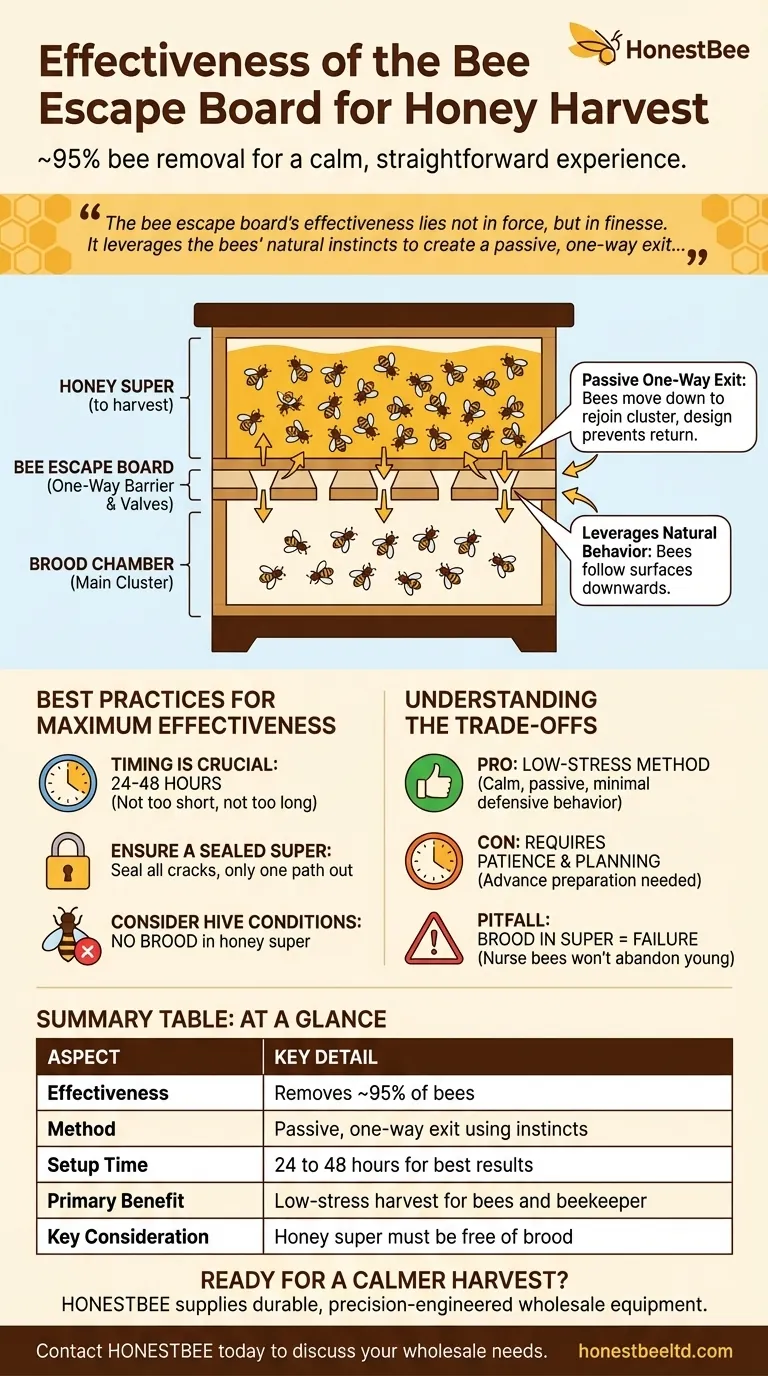In short, the bee escape board is a highly effective tool for clearing bees from a honey super before harvesting. When used correctly, it can remove approximately 95% of the bees, creating a calm and straightforward harvesting experience for both the beekeeper and the colony.
The bee escape board's effectiveness lies not in force, but in finesse. It leverages the bees' natural instincts to create a passive, one-way exit, making it one of the least stressful methods for preparing a honey super for harvest.

How a Bee Escape Board Works
To use a tool effectively, you must first understand its mechanism. The bee escape board is a simple yet ingenious device that works with bee biology, not against it.
The Core Principle: A One-Way Exit
At its heart, the board is a physical barrier placed between the honey supers you intend to harvest and the brood chamber below. It contains one or more small "escapes" or valves designed to let bees move downwards into the brood chamber but prevent them from traveling back up into the super.
Leveraging Natural Bee Behavior
Bees naturally move between the brood nest and the honey storage areas. As they move down through the escape, the design of the exit prevents their return.
For example, the common Triangle Escape Board works because bees tend to follow surfaces. When they encounter the barrier from below, they are funneled away from the entrance, but when they approach from above, the triangular "maze" guides them easily through the exit.
The Process in Practice
The process is straightforward. You place the board directly underneath the honey supers you want to clear. The bees in the super, seeking to rejoin the main cluster in the brood box, will gradually find the exits and move down.
Best Practices for Maximum Effectiveness
Success with a bee escape board depends entirely on proper timing and setup. Simply placing the board on the hive is not enough.
Timing is Crucial
The board needs to be in place for 24 to 48 hours. Leaving it on for just a few hours will not give enough bees time to move down. If left on for more than two days, some clever bees may find their way back into the supers.
Ensure a Sealed Super
The one-way exit is useless if the bees have another way in. Before installing the board, inspect your honey supers for any cracks, holes, or gaps. Seal any alternate entrances to ensure the escape board is the only path in or out.
Consider Hive Conditions
The board works best on a strong, healthy colony during good flying weather. A hive with a laying queen in the honey super will not be cleared effectively, as nurse bees will not abandon the brood.
Understanding the Trade-offs
Like any tool, the bee escape board has distinct advantages and disadvantages that make it suitable for some situations but not others.
Pro: A Low-Stress Method
This is the primary benefit. Unlike fume boards that use chemical repellents or blowers that violently force bees out, the escape board is a calm, passive method. It minimizes bee stress, reduces the risk of defensive behavior, and is much quieter for the beekeeper.
Con: It Requires Patience and Planning
The main drawback is time. You cannot decide to harvest and pull honey on the same day. Using an escape board requires you to prepare the hive at least one or two days before your planned harvest time.
Pitfall: Brood in the Honey Super
The most common reason for failure is the presence of bee brood (eggs, larvae, or pupae) in the honey supers. The worker bees' instinct to care for the young is stronger than their instinct to move down to the main cluster, and they will not abandon the brood. Always ensure your supers are free of brood before using an escape board.
Making the Right Choice for Your Harvest
Ultimately, the bee escape board's value is determined by your personal beekeeping goals and harvesting style.
- If your primary focus is a calm, low-stress harvest: The bee escape board is the ideal method due to its gentle, passive nature that protects bee and beekeeper well-being.
- If your primary focus is speed and on-demand harvesting: This method is not for you, as it requires a 24-48 hour waiting period that necessitates advance planning.
By understanding and leveraging the bees' natural instincts, the escape board offers an exceptionally effective way to prepare for a successful and peaceful honey harvest.
Summary Table:
| Aspect | Key Detail |
|---|---|
| Effectiveness | Removes ~95% of bees from the honey super |
| Method | Passive, one-way exit using bee instincts |
| Setup Time | Requires 24 to 48 hours for best results |
| Primary Benefit | Low-stress harvest for bees and beekeeper |
| Key Consideration | Honey super must be free of brood to work effectively |
Ready for a Calmer Harvest?
For commercial apiaries and beekeeping equipment distributors, efficiency and bee welfare are paramount. The right equipment makes all the difference.
HONESTBEE supplies durable, precision-engineered beekeeping supplies and equipment through wholesale-focused operations. Let us help you equip your operation for success with tools that protect your bees and streamline your workflow.
Contact HONESTBEE today to discuss your wholesale needs and discover how our equipment can contribute to your productive and peaceful apiary.
Visual Guide

Related Products
- HONESTBEE Wooden Bee Escape Board with Triangle Mesh Design for Beekeeping
- Heavy Duty Metal Corner Bee Escape for Reliable Hive Clearing
- Circular Labyrinth Bee Escape for Efficient Hive Management
- Durable 16 Way Circular Bee Escape for Efficient Honey Harvesting
- Slatted Porter Style Bee Escape for Rapid Hive Clearing
People Also Ask
- Where should the triangle escape board be placed in the hive? Master a Gentle, Stress-Free Honey Harvest
- What precautions should be taken when using the triangle escape board? Master Gentle Honey Harvesting
- What are the available frame sizes for Triangular Escape Boards? Find the Perfect Fit for Your Hive
- What are the recommended conditions for using the triangle bee escape board? Ensure a Successful, Low-Stress Honey Harvest
- What types of bee escape boards are available? Clear Your Supers Fast and Stress-Free



















